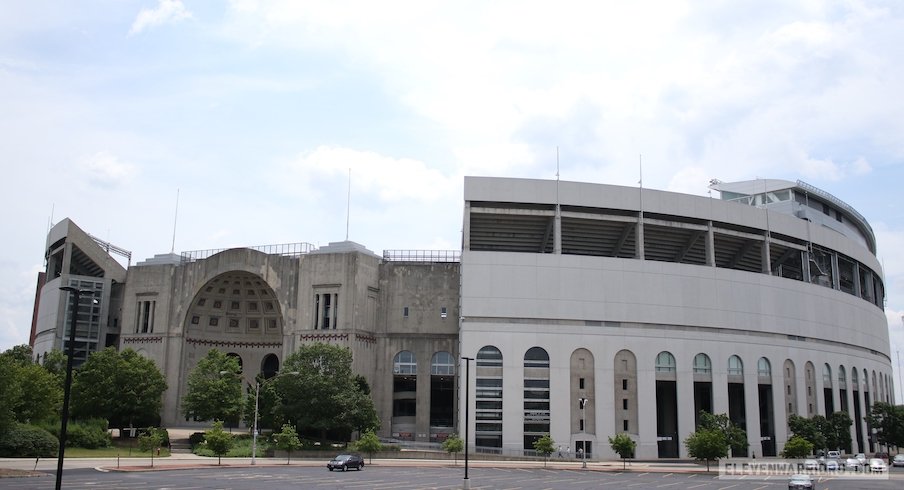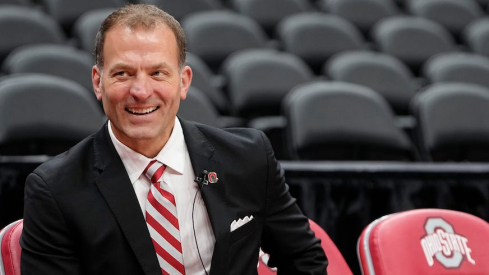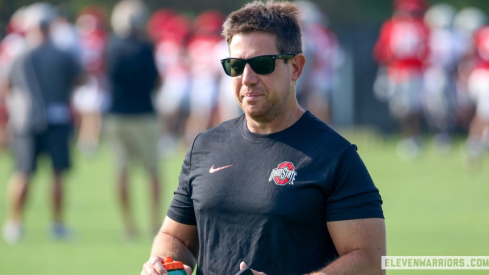The budget cuts in Ohio State’s athletic department could have been much steeper.
Ohio State announced Wednesday it is eliminating 25 full-time positions from its athletic department while nearly 400 other staff members will be furloughed, redeployed or taking voluntary 5 percent pay cuts. But the athletic department would have had to lay off more employees, institute longer furloughs and ask for larger pay cuts if the Big Ten hadn’t scheduled a fall football season beginning in October.
Gene Smith said Wednesday that the athletic department intentionally waited to finalize any budget decisions, even after the Big Ten moved to postpone fall sports on Aug. 11 and claimed eight days later that the decision “would not be revisited,” with the hope that football would still be played this fall, enabling Ohio State to recoup some of the revenue it had projected to lose.
“Our furlough and reduction-in-force plan was significantly more challenging prior to the announcement that football would come back,” Smith said during a call with reporters. “We decided that we had a chance for it to be available in the fall, so we held out and we reduced the impact significantly. It’s still major impact, but it’s not as bad as it would have been if football didn’t come back in the fall.”
Just how much revenue Ohio State will bring in from its fall season remains uncertain, as the Big Ten is still negotiating with its television partners to determine just how much the media rights to the fall season will be worth. Ohio State already knows it will lose a sizable chunk of its typical football season revenue since it will not be hosting fans at Ohio Stadium this fall, but its deficit for the 2021 fiscal year will ultimately be less than the current projection of $107 million, since that projection does not include TV revenue.
Smith doesn’t know right now what the revised television contracts will look like; even though the Big Ten listed him as a member of the television subcommittee on its Return to Competition Task Force, he said Wednesday that he is not actually on that committee. But he knows they could be subject to change even once the season begins due to the reality that games could be canceled due to the ongoing COVID-19 pandemic.
“Hopefully we can play all the way through but if we don’t, then that number changes again,” Smith said.
Currently, Ohio State is counting on $73 million in revenue for the 2020-21 academic year, including $28.6 million in development, $13.4 million in NCAA and Big Ten basketball tournament and bowl game distribution, $5.8 million from its IMG/Learfield partnership, $4.6 million in endowment and investment income, $4.6 million from the Ohio State University Golf Course, $2 million in trademark and licensing, $1.7 million in camps and clinics and $1.1 million from a limited home men’s basketball season.
Smith admitted Wednesday, though, that all of those projections are just “guesstimates” as of now. With so much still up in the air because of the pandemic – including what basketball season will look like and spring seasons for Ohio State’s other fall sports will look like – all of those numbers are subject to change, though Smith hopes more clarity will come in the next few weeks.
“You have the numbers, but I’m gonna just be quite frank with all of you: They mean nothing at this point in time relative to accuracy,” Smith said.
While Smith is hopeful Ohio State will be able to have double-digit home basketball games, those games will also be played with either no fans in attendance or significantly smaller crowds than usual. And if the other fall sports play full schedules in the spring, that will increase expenses, as those sports don’t generate the profits the football and basketball team do. Ohio State also knows that its sponsorship and annual giving revenues will be down, while the athletic department will also lose revenue streams from concessions, parking and concerts at its athletic facilities.
Ohio State still might have to make its contractually guaranteed payouts to Bowling Green ($1.2 million) and Buffalo ($1.8 million) for the non-conference football games that were supposed to happen earlier this month, though Smith said OSU is still working to negotiate agreements with those schools. If that doesn’t happen, those payouts – which they are required to make by Feb. 28 – will be taken from the television revenue that isn’t currently reflected in OSU’s budget projections.
In order to cover its losses this year, Smith said the athletic department will likely have to take an internal loan from the institution at-large. If the athletic department does that, though, it will have a long-term debt recovery plan – which will mean budgeting to pay back that loan in future years – as the athletic department is committed to being self-sustaining rather than being subsidized by the university.
“We’ve been self-supporting, and we’ll continue to be self-supporting,” Smith said. “We don’t want to be a burden to the institution, we want to be an asset. That’s what we want to do. And there’s a focus on making sure we maintain that status as an athletic department, which is why we’re doing what we’re doing. So that’s very important to us.”
Despite all of that, Smith said there have not been any major conversations about cutting any of Ohio State’s 36 varsity sports. While he said “everything is an available option as we move into the future,” he also pointed out that cutting sports wouldn’t necessarily result in significant cost savings because most athletes in sports other than football and basketball don’t receive full scholarships.
“We all love football, we focus on football, that’s what we do,” Smith said. “But when you think about the other sports and you see them winning national championships or you see them winning conference championships and you see them performing at the top end academically and you see them graduating and staying in Central Ohio and staying in Columbus and becoming contributors to our environment, there’s lessons learned in those sports that are equivalent to football. They are.
“So what we have done with a number of those sports is reduced the expenditures in their operations, and the coaches have been great about that, but when you start to actually do the math on your scholarship count, many of them are paying their own way.”
“We’ve been self-supporting, and we’ll continue to be self-supporting. We don’t want to be a burden to the institution, we want to be an asset.”– Gene Smith on Ohio State's athletic department
Ohio State will still have to consider other ways to reduce their expenses, though, potentially including same-day travel and bus trips for the football team to closer locations – like East Lansing, where Ohio State will play Michigan State on Dec. 5 – depending on game times. Smith said Ohio State will not look to reduce its football coaching salaries or recruiting expenditures, recognizing that level of spending is vital for the Buckeyes to compete for national championships, but it will look for ways to cut costs that don’t affect performance or athlete welfare, such as reducing the number of people other than players and coaches who travel with the team to road games.
Realistically, every college athletic department in the country is going to have to make budget cuts due to the pandemic – regardless of whether they have done so already – and Ohio State, even as one of the nation’s most prolific athletic departments, is far from immune. As a result, it's going to have to re-evaluate all of its expenditures and consider additional ways it could save costs, as it faces the reality that it will take years to make up for the lost revenue of this year.
“Everything we do now is being rethought,” Smith said. “None of us, you or anyone, have experienced what we’ve experienced in the pandemic. None of us. And so it’s caused you to think differently about a whole lot of things.”


